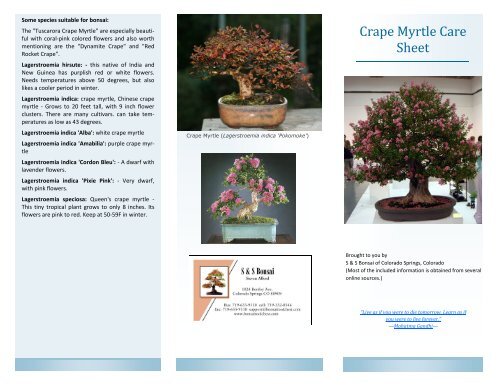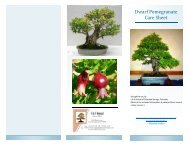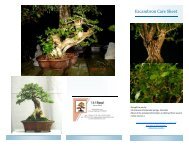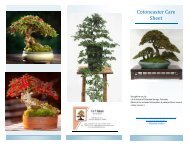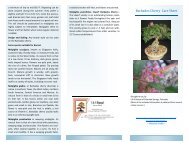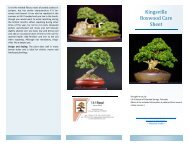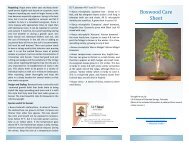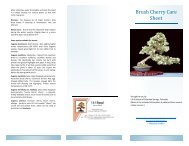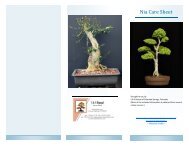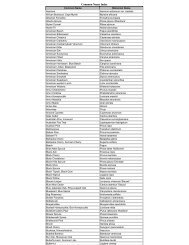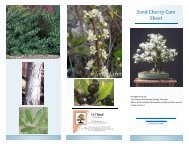Crape Myrtle Care Sheet
Crape Myrtle Care Sheet
Crape Myrtle Care Sheet
- No tags were found...
Create successful ePaper yourself
Turn your PDF publications into a flip-book with our unique Google optimized e-Paper software.
Some species suitable for bonsai:<br />
The "Tuscarora <strong>Crape</strong> <strong>Myrtle</strong>" are especially beautiful<br />
with coral-pink colored flowers and also worth<br />
mentioning are the "Dynamite <strong>Crape</strong>" and "Red<br />
Rocket <strong>Crape</strong>".<br />
Lagerstroemia hirsute: - this native of India and<br />
New Guinea has purplish red or white flowers.<br />
Needs temperatures above 50 degrees, but also<br />
likes a cooler period in winter.<br />
Lagerstroemia indica: crape myrtle, Chinese crape<br />
myrtle - Grows to 20 feet tall, with 9 inch flower<br />
clusters. There are many cultivars. can take temperatures<br />
as low as 43 degrees.<br />
Lagerstroemia indica 'Alba': white crape myrtle<br />
Lagerstroemia indica 'Amabilia': purple crape myrtle<br />
Lagerstroemia indica 'Cordon Bleu': - A dwarf with<br />
lavender flowers.<br />
Lagerstroemia indica 'Pixie Pink': - Very dwarf,<br />
with pink flowers.<br />
Lagerstroemia speciosa: Queen's crape myrtle -<br />
This tiny tropical plant grows to only 8 inches. Its<br />
flowers are pink to red. Keep at 50-59F in winter.<br />
<strong>Crape</strong> <strong>Myrtle</strong> (Lagerstroemia indica 'Pokomoke')<br />
<strong>Crape</strong> <strong>Myrtle</strong> <strong>Care</strong><br />
<strong>Sheet</strong><br />
Brought to you by<br />
S & S Bonsai of Colorado Springs, Colorado<br />
(Most of the included information is obtained from several<br />
online sources.)<br />
“Live as if you were to die tomorrow. Learn as if<br />
you were to live forever.”<br />
—Mahatma Gandhi—
The <strong>Crape</strong> <strong>Myrtle</strong><br />
(Lagerstroemia indica )<br />
General Information: Genus of 50 species of deciduous<br />
or evergreen trees occurring in deciduous woodland,<br />
often near rivers, in warm-temperate and tropical<br />
regions from Asia to Australia. The species commonly<br />
used for bonsai is Lagerstroemia communis or<br />
Lagerstroemia indica, the <strong>Crape</strong> <strong>Myrtle</strong>.<br />
L. indica is an upright, deciduous tree with peeling,<br />
grey and brown bark and small dark-green, opposite<br />
leaves to 8cm. Each plant has separate male and female<br />
flowers; vast numbers appear in Summer clothing<br />
the tree in white, pink, red or purple depending<br />
on the variety.<br />
<strong>Crape</strong> myrtle makes an excellent bonsai due to its<br />
exquisite branch ramification and the contrast of the<br />
red upon silver of the peeling bark. Native to Asia, the<br />
crape myrtle is very common in the southern US,<br />
having been introduced over 150 years ago. It has<br />
small pink, white or purple flowers, but is often displayed<br />
in winter to show off its trunk and branch<br />
structure. It gets its common name from its crepelike,<br />
crinkled petals, and the resemblance of its leaves<br />
to the true myrtle, Myrtus communis, thus sometimes<br />
spelled Crepe myrtle. In cooler climates the leaves<br />
turn autumn colors before dropping its leaves. The<br />
<strong>Crape</strong> myrtle has a smooth bark that exfoliates in<br />
patches as it ages. The crape myrtle produces many<br />
different colors of flowers which appear in sprays in<br />
colors such as white, pink, purple, lavender, and watermelon<br />
red among others, depending upon the<br />
variety. Flowers appear on new wood from summer<br />
to winter. There are also dwarf or miniature varieties<br />
available such as 'Pocomoke'.<br />
Pocomoke variety is a Dwarf <strong>Crape</strong> <strong>Myrtle</strong> which has<br />
small, shiny, dark green foliage, the new foliage starts<br />
out a bronze color changing to green. The Pocomoke<br />
variety flower color is a deep rose color and the flowers<br />
usually appear single as opposed to larger species<br />
which form in sprays. Protect from frosts.<br />
CARE<br />
Temperature: Zones 7-9A, although some of the<br />
dwarf cultivars can be grown as far north as zone 5.<br />
Can be successfully grown as an indoor plant; if this<br />
is done it should be kept at a temperature of 45°-<br />
54°F in the winter to stimulate dormancy - the<br />
crape myrtle should drop its leaves. In cooler climates<br />
the leaves turn autumn colors before dropping.<br />
If it is exposed to a combination of warm temperatures<br />
and low light (as inside many houses in<br />
winter) the crape myrtle's new growth will be leggy<br />
and sappy. The plant will only flower during a<br />
warm, dry summer.<br />
<strong>Myrtle</strong>s are not fully hardy and need to be brought<br />
indoors from October to May when there is a risk<br />
of night temperatures dropping below 35-38°F.<br />
Overwinter in a position in a partially heated room<br />
where temperatures are allowed to drop at night<br />
to allow leaf-drop and dormancy. <strong>Myrtle</strong>s grown in<br />
areas with high summer temperatures are able to<br />
ripen growth relatively quickly and are more winter<br />
hardy.<br />
Lighting: Full sun. This helps to keep it relatively<br />
pest and fungus free and promotes flowering. In<br />
summer <strong>Myrtle</strong>s need to placed outside in a sunny<br />
position though they will tolerate a sunny position<br />
indoors.<br />
Watering: This tree likes a lot of water but only<br />
with well draining soil. Frequently in spring, moderately<br />
during the rest of the year. To promote flowering,<br />
allow the soil to dry slightly (similar to bougainvillea).<br />
Reduce watering in winter and just before<br />
flowering to encourage bud formation. Ensure<br />
good humidity levels are provided by use of a<br />
gravel tray.<br />
Fertilizing: p.H. should be kept between 6.5 - 7.5.<br />
Feed every two weeks from Spring to Autumn. Use<br />
a balanced plant food such as BonsaiPro diluted to<br />
1/2 strength weekly or 12-10-10 slow release<br />
graduals during the growing season and a slow release<br />
type 2-10-10 over the winter as directed. Al-<br />
ternate bonsai food with a low nitrogen, high<br />
phosphate fertilizer. Do not feed during the winter<br />
when dormant.<br />
Pruning / Training: Do not prune until Autumn as<br />
flower buds are formed on growth that develops<br />
from early Summer onwards. The safest method is<br />
to prune only in autumn, and in any case, a good<br />
autumn pruning will stimulate bud production for<br />
next year.<br />
It is recommended to cut the crape myrtle back<br />
severely in the Autumn, then allowing it to grow<br />
freely for a year to thicken the trunk. The next<br />
year, pinch the tree constantly to promote branch<br />
ramification. If pruning is discontinued shortly<br />
before the flowering period, it may still flower.<br />
<strong>Myrtle</strong>s produce many upward growing shoots<br />
that need wiring down to produce branch structure,<br />
wiring is very easily carried out until<br />
branches reach 3 to 4 years of age at which point<br />
they become very brittle and snap easily. The<br />
branches are delicate, however, and it is just as<br />
easy to shape through pruning due to the excellent<br />
branch ramification.<br />
Insects / Pests: Mealy bugs, scale, red spider<br />
mites and whiteflies can be a problem on indoor<br />
trees.<br />
Propagation: Sow seed at 50-55°F in Spring. Root<br />
softwood cuttings in late Spring or semi-ripe cuttings<br />
with bottom heat in Summer.<br />
Repotting: Annually in Spring as new growth commences,<br />
most safely done before bud burst and<br />
only when the night temperatures are in the upper<br />
50's F. The <strong>Crape</strong> <strong>Myrtle</strong> is a fast grower and<br />
does not like to be root bound. Pot in a basic soil<br />
mix.<br />
Design and Styling: Informal upright forms, cascade<br />
forms in medium to extra-large sizes. The<br />
dwarf varieties make excellent shohin bonsai.


